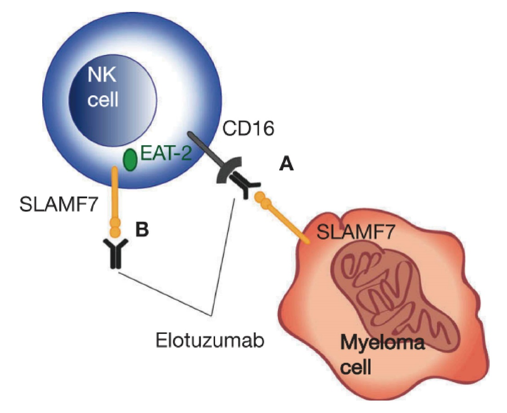
Our promise to you:
Guaranteed product quality, expert customer support.
 24x7 CUSTOMER SERVICE
24x7 CUSTOMER SERVICE
 CONTACT US TO ORDER
CONTACT US TO ORDER
SLAMF7 Gene Editing 
The SLAMF7 (CRACC, CD319, CS-1) receptor is a member of the signaling lymphocytic activation molecules (SLAM) family of receptors, with expression limited to hematopoietic cells, and exists at differing frequencies on various types of immune cells. SLAMF7, and other SLAM family members (except 2B4), are unique in that they function as homotypic receptors. Once activated, they recruit various SH2 domain-containing proteins to their cytoplasmic immunoreceptor tyrosine-based switch motifs. By doing so, SLAMF7 can modulate a host of immune cell-specific functions across various immune cell types.
The Expression of SLAMF7
Both plasma cells and multiple myeloma (MM) cells seem to express high levels of SLAMF7 mRNA and protein, which has been confirmed in animal models, human cell lines and primary patient samples. Hsi et al. confirmed that other normal lymphocyte subsets, such as CD8+ T cells, NK cells, NK-like T cells, activated monocytes and dendritic cells, also express SLAMF7, although at lower levels than normal plasma cells. In addition, SLAMF7 is expressed in all populations of patients with MM independent of cytogenetic abnormalities, high-/low-risk molecular profile, stage of disease, or disease status (newly diagnosed/relapsed). The selective expression of SLAMF7 on plasma cells, coupled with the lack of expression in the parenchyma of any major organs or on hematopoietic stem cells used for autologous stem cell transplantation (ASCT), makes SLAMF7 an attractive target for the treatment of MM.
Anti-SLAMF7: Mode of Action in MM
Elotuzumab is a first-in-class immunostimulatory humanized immunoglobulin G1 mAb targeted against SLAMF7, a glycoprotein expressed on MM cells. Elotuzumab may play an anti-MM role through indirect mechanisms, such as NK cell activation, antibody-dependent cellular phagocytosis (ADCP) by macrophages, NK-mediated antibody-dependent cellular cytotoxicity (ADCC), and blockade of the interaction of MM cells with stromal cells in the bone marrow niche. First, elotuzumab showed an antibody-dependent cellular cytotoxicity (ADCC) in myeloma cell lines, not only in autologous primary myeloma cells, but also in myeloma cells of RRMM patients. Targeting of the SLAMF7 receptor inhibited MM cell adhesion to BMSCs. Finally, elotuzumab appears to induce NK cell activation by binding of the Fc portion of elotuzumab to the Fc receptor (CD16) on NK cells. This process requires an association with its adaptor protein (EAT-2), which exists on NK cells, but not on MM cells. This activation results in the degranulation and release of perforin granules, which in turn leads to myeloma cell death. Elotuzumab promotes CS1-CS1 interaction between NK cells and CS1(+) target cells (such as MM cells) to increase cytotoxicity in a manner independent of ADCC. Elotuzumab does not cause complement-dependent cytotoxicity.
 Figure 1. Elotuzumab mechanism of action. (Lonial S, et al., 2016)
Figure 1. Elotuzumab mechanism of action. (Lonial S, et al., 2016)
SLAMF7 Gene Editing Services
CRISPR/Cas9 PlatformCB, one of the leading biotechnological companies specializing in gene editing, is dedicated to offering comprehensive CRISPR/Cas9 gene-editing services to a wide range of genomics researchers. Based on our platform, we can help you effectively SLAMF7 gene deleted, inserted or point mutated in cells or animals by CRISPR/Cas9 technology.
- SLAMF7 Gene Knockout: We offer SLAMF7 gene knockout cell line and knockout animal model generation service with high quality. Typically, we develop CRISPR-mediated gene editing cell lines including HEK239T, Hela, HepG2, U87, but we can use other cell lines according to your requirements. Our one-stop KO animal model generation service covers from sgRNA design and construction, pronuclear microinjection to Founders genotyping and breeding.
- SLAMF7 Gene Knockin: CRISPR/Cas9 PlatformCB provides the one-stop SLAMF7 knock-in cell line and knockout animal model generation services, including point mutation and gene insertion. Our expert staff has succeeded in dozens of SLAMF7 knock-in cell line generation projects, including stem cells, tumor cells and even difficult-to-handle cells. We also have extensive experience in incorporating CRISPR/Cas9 technology into animal models, which have been fully recognized by our clients.
If you have any questions, please feel free to contact us.
Related Products at CRISPR/Cas9 PlatformCB
References
- Friend R, et al. Clinical potential of SLAMF7 antibodies–focus on elotuzumab in multiple myeloma. Drug design, development and therapy, 2017, 11: 893.
- Lonial S, et al. Update on elotuzumab, a novel anti-SLAMF7 monoclonal antibody for the treatment of multiple myeloma. Expert opinion on biological therapy, 2016, 16(10): 1291-1301.
- Boudreault J S, et al. The role of SLAMF7 in multiple myeloma: impact on therapy. Expert review of clinical immunology, 2017, 13(1): 67-75.
- Kikuchi J, et al. Soluble SLAMF7 promotes the growth of myeloma cells via homophilic interaction with surface SLAMF7. Leukemia, 2020, 34(1): 180-195.
- O'Connell P, et al. SLAMF7 signaling reprograms T cells toward exhaustion in the tumor microenvironment. The Journal of Immunology, 2021, 206(1): 193-205.